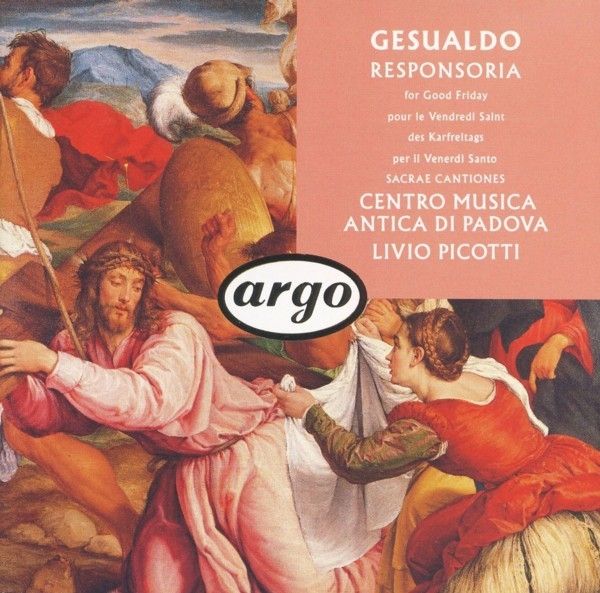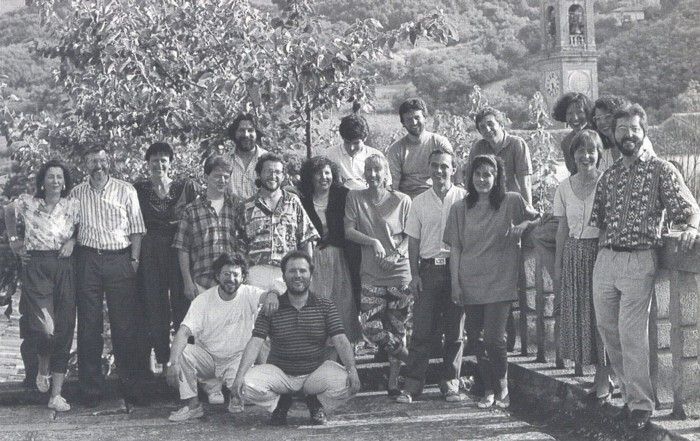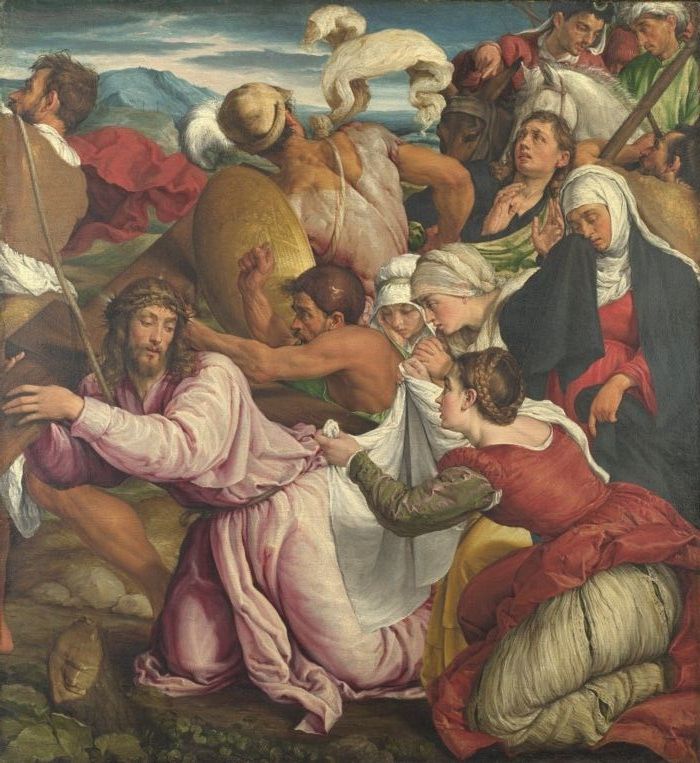Carlo GESUALDO. Responsoria / Musica Antica di Padova
Sacrae Cantiones · Responsoria et alia ad Officium Hebdomadae Sanctae, FERIA VI

amazon.com
argo 430 832-2 DECCA/London
1991
Carlo GESUALDO (c.1560-1613)
Sacrae Cantiones
1. Ave, Regina coelorum [2:37]
2. Ave, dulcissima Maria [3:14]
3. Dignare me, laudare te [1:45]
4. Precibus et meritis beatae Mariae [2:16]
5. Maria, Mater gratiae [2:50]
6. Miserere mei, Deus (Psalm 50) [8:25]
Responsoria et alia ad Officium Hebdomadae Sanctae spectantia
FERIA VI
7. Resp. 1. Omnes amici mei [3:47]
8. Resp. 2. Velum templi [3:48]
9. Resp. 3. Vinea mea electa [4:31]
10. Resp. 4. Tamquam ad latronem [2:57]
11. Resp. 5. Tenebrae factae sunt [3:52]
12. Resp. 6. Animam meam dilectam [6:26]
13. Resp. 7. Tradiderunt me [2:38]
14. Resp. 8. Jesum tradidit impius [3:47]
15 - Resp. 9. Caligaverunt oculi mei [5:28]
I MADRIGALISTI DEL CENTRO MUSICA ANTICA DI PADOVA
Conductor: Livio Picotti
sopranos
Anna Maria De Filippo (A, B, C)
Hélène Kuhn (C)
Patrizia Sartore (C)
Bianca Simone (A, B, C)
Elisabetta Tiso (A, B, C, c)
Ulrike Wurdak,(A, B, C, c)
altos
Paolo Costa (A, B, b, C, c)
Luisa Fontanieri (A, B, C)
Viviana Giorgi (C)
tenors
Augusto Bellon (A, B, C)
Vittorino Ciato (C)
Stefano Dal Cortivo (A, B, b, C)
Alessandro Gargiulo (A, B, C, c)
Alessandro Magagnin (C)
Alberto Mazzocco (A, B, b, C, c)
basses
Adriano Calzavara (C)
Daniele Carnovich (A, B, b, C, c)
Roberto Moro (A, B, C)
A: SACRED SONGS
B: Miserere— b: Gregorian chant in the Miserere
C: RESPONSES — c: Response verses

Carlo Gesualdo, Musician and Murderer
For most of us, the eye-catching title of Cecil Gray and Philip
Heseltine's biography of Gesualdo represents what we remember most
clearly about the composer: that he was a Neapolitan nobleman for whom
music was a ruling passion; that in his late twenties (on 16 October
1590) he contrived the murder of his first wife, Maria d'Avalos, and
her lover the Duke of Andria, whom he surprised 'in flagrante delicto';
that he wrote madrigals characterised by apparently wayward changes of
harmony and rhythm and chromatic writing of a particularly daring kind;
and that he showed symptoms of mental derangement during the final
years of his life. Nevertheless, the romantic notion that murder,
madness and chromatic madrigals are somehow inextricably bound together
is altogether too simple a view both of Gesualdo's output and of his
development as a composer.
Gesualdo's second marriage, to Leonora d'Este, brought him into contact
with the musical establishment at the court of Ferrara, and on his
visits there between 1594 and 1596 he seems to have spent much of his
time in composing and music-making. At Ferrara there was already a
well-established tradition of composing chromatic madrigals, and
Gesualdo seems to have learned much from his contact with composers
such as Luzzasco Luzzaschi and Count Alfonso Fontanelli, as well as
stimulating them to publish their own music. The first four of his
madrigal books were published at Ferrara, and in the third and fourth
of these we can see Gesualdo seeking new ways to capture the emotional
content of the texts that he set. In his fifth and sixth books, which
were not published until 1611, towards the end of his life, we can see
him carrying to extremes the devices of chromaticism and disrupted
textures that he began to explore at Ferrara.
Madrigals, however, form only one part of Gesualdo's output. They
represent his 'private' voice, his attempt to extend the expressive
possibilities of musical language in a form that was reserved for
connoisseurs. And if he explored further than his contemporaries dared,
the explanation may lie not in psychopathology, but rather in the fact
that he was answerable to no patron but himself. Certainly in his
settings of sacred texts Gesualdo seems deliberately to have adopted a
more restrained and easily approachable 'public' voice. This is evident
in the two volumes of Sacrae cantiones that he published in Naples in
1603. The first of these, from which the five Marian motets on this
recording are taken, contains works for five voices only; the second is
devoted to music for six and seven voices. A few of the texts that
Gesualdo chose belong to the liturgy — as in the antiphon 'Ave,
Regina coelorum', which is sung after Compline from 2 February to the
Wednesday in Holy Week — but most are extraliturgical, and were
probably used either for private devotions or for insertion into the
liturgy at opportune moments. In setting these texts Gesualdo did not
forgo chromaticism altogether, but he contained it within a generally
long-breathed and limpid contrapuntal style. Above all, he avoided the
sudden changes of rhythm which so disrupt the later madrigals.
Given Gesualdo's interest in trying to find musical expression for the
most deeply-felt emotions, it is not surprising that he was drawn to
setting the texts of the responsories for Holy Week, which convey the
anguish of Christ's betrayal, suffering and death. In his Responsoria,
published in 1611 (the same year as the daring fifth and sixth books of
madrigals) Gesualdo included settings of all twenty-seven of the
responsories appointed for the office of Matins on Maundy Thursday,
Good Friday and Holy Saturday, together with settings of the Miserere
(Psalm 50; Authorised Version 51) and the canticle 'Benedictus Dominus
Deus Israel'. The nine responsories recorded here are those for Good
Friday.
Gesualdo did not intend his responsories as concert pieces, nor were
they meant to be heard one after the other. In their original context
— the pre-dawn office of Matins — they would have been
separated by items sung in plainsong. In the Counter-Reformation
Church, Matins consisted of three units known as 'Nocturns', each of
which consisted of three psalms chanted to a plainsong formula,
followed by a versicle and response and three lessons, likewise intoned
in plainsong. Each of the lessons were followed by one of the
responsory texts that Gesualdo set. After the third Nocturn, the
service was completed by a performance of the Miserere, which Gesualdo
set in the traditional manner (alternating plainsong and polyphony). In
Gesualdo's time, Matins in Holy Week would have been followed
immediately by the dawn office of Lauds, with five further psalms and
the canticle 'Benedictus Dominus Deus Israel'. And to symbolise
Christ's descent into the shadows (the 'tenebrae' from which this
extended service takes the name by which it is often known), candles on
a sixteen-branch candlestick were extinguished — one after each
of the fifteen psalms, and the final one after 'Benedictus Dominus Deus
Israel'.
Despite their positioning as postludes to the Lessons, it is in fact
the responsories that carry the Passion narrative and the Psalms and
Lessons that form meditations upon it. In the Good Friday service, the
first three responsories followed Psalms 2, 21 (AV 22) and 26 (AV 27)
and Lessons drawn from the Lamentations of Jeremiah (2:8-11; 2: 12-15;
3: 1-9); the second three followed Psalms 37 (AV 38), 39 (AV 40) and 53
(AV 54) and Lessons drawn from St Augustine's interpretation of Psalm
63 (AV 64) as a commentary on the Passion; and the final three followed
Psalms 58 (AV 59), 87 (AV 88) and 93 (AV 94) and Lessons from St Paul's
letter to the Hebrews (4: 11-15; 4: 16 and 5: 1-3; 5: 4-10). Over the
three final days of Holy Week, then, the 'Tenebrae' services formed a
large-scale presentation of, and meditation upon, the Passion story,
and Gesualdo's responsory settings are a distinguished contribution to
the history of Passion music. Far from being the eccentric outpourings
of a deranged mind, they are cogent, persuasive and powerful. In
particular, Gesualdo's setting of the words 'Videte, omnes populi, si
est dolor similis sicut dolor meus', which forms the climax of the
ninth Good Friday responsory, must rank as the equal of any setting of
this most moving text.
John Whenham



